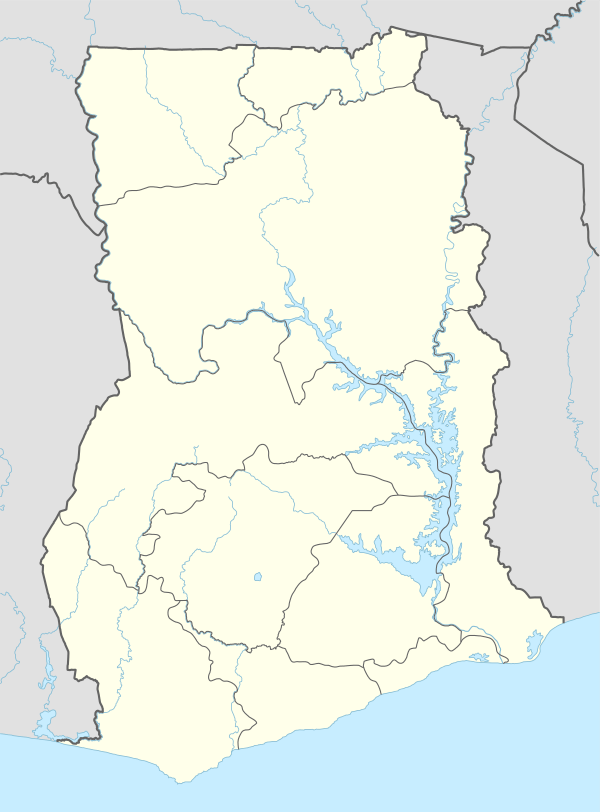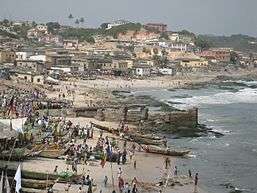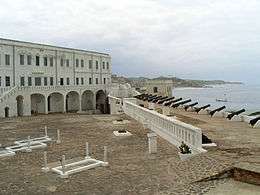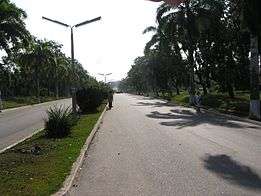Cape Coast
| Cape Coast, Oguaa City of Cape Coast | ||
|---|---|---|
| City | ||
|
1st Top-Left image; Arch bridge and Harbour view from Elmina Castle in Cape Coast • 2nd Bottom-Left image; City hall of Cape Coast • 1st Top-Right image; Shores of Cape Coast • 2nd Bottom-Right image; Balcony of Cape Coast Castle. | ||
| ||
 Cape Coast, Oguaa Location of Cape Coast in Central Region, Ghana. | ||
| Coordinates: 05°06′00″N 01°15′00″W / 5.10000°N 1.25000°W | ||
| Country |
| |
| Admin. Region | Central Region | |
| District | Cape Coast Metropolitan | |
| Founded | 1482 | |
| Elevation | 0 m (0 ft) | |
| Population (2012) | ||
| • Total | 169,894[1] | |
| • Demonym | Cape Coaster | |
| Time zone | GMT | |
| • Summer (DST) | GMT (UTC) | |
Cape Coast, or Cabo Corso, is a city and fishing port, and the capital of Cape Coast Metropolitan District and Central Region of south Ghana. Cape Coast is situated on its south to the Gulf of Guinea. Cape Coast had a settlement population of 169,894 people (2010 census).[1] From the 16th century until Ghanaian independence, the city and fishing port changed hands between the British, the Portuguese, the Swedish, the Danish and the Dutch.
History
Cape Coast was founded by the people of Oguaa. The Portuguese built a trading fort in the area. In 1610 the Swedes built a lodge that would later become the better known Cape Coast Castle now a World Heritage Site. Most of the modern town expanded around it. The Dutch took it over in 1650, and expanded it in 1652. It was then captured by the British in 1664. Trade was an important motivator in the creation of fortresses and settlements on Cape Coast. Traders from various European countries built these trading lodges, forts and castles along the coast of modern Ghana. Unfortunately, the acquisition of gold, slaves, honey, and the many other African goods that consisted the African leg of the Triangular Trade was increasingly detrimental to the inhabitants of Cape Coast.[2] In 1874, the British dominated all European presence along the coast of modern-day Ghana using Cape Coast as their base of operations, Gold Coast. With the establishment of formal colonial administration, they relocated to Accra following opposition to the "window tax" in 1877. Accra became their state. Cape Coast Castle was also where most of the slaves were held before their journey on the Middle Passage.
Geography
Topography
The area is dominated by batholith rock and is generally undulating with steep slopes. There are valleys of various streams between the hills, with Kakum being the largest stream.
The minor streams end in wetlands, the largest of which drains into the Fosu Lagoon at Bakano. In the northern part of the district, however, the landscape is suitable for the cultivation of various crops.[3]
Climate
- Temperature
Cape Coast is a humid area with mean monthly relative humidity varying between 85% and 99%. The sea breeze has a moderating effect on the local climate.[3]
| Climate data for Cape Coast | |||||||||||||
|---|---|---|---|---|---|---|---|---|---|---|---|---|---|
| Month | Jan | Feb | Mar | Apr | May | Jun | Jul | Aug | Sep | Oct | Nov | Dec | Year |
| Average high °C (°F) | 32 (89) |
31 (87) |
31 (87) |
31 (87) |
30 (86) |
29 (84) |
27 (80) |
27 (80) |
26 (79) |
28 (83) |
31 (87) |
30 (86) |
32 (89) |
| Average low °C (°F) | 24 (75) |
24 (76) |
24 (76) |
25 (77) |
24 (76) |
24 (75) |
23 (73) |
22 (71) |
21 (70) |
23 (73) |
24 (76) |
23 (74) |
23 (73) |
| Average precipitation mm (inches) | 25 (1.0) |
25 (1.0) |
76 (3.0) |
127 (5.0) |
229 (9.0) |
229 (9.0) |
102 (4.0) |
25 (1.0) |
76 (3.0) |
102 (4.0) |
127 (5.0) |
152 (6.0) |
1,300 (51) |
| Source: Myweather2.com[4] | |||||||||||||
Attractions
The crab is the city's mascot and a statue of one stands in the city centre. Fort William, built in 1820, was an active lighthouse from 1835 to the 1970s, while Fort Victoria was built in 1702.
Other attractions include a series of Asafo Shrines, Cape Coast Centre for National Culture, the Oguaa Fetu Afahye harvest festival, and since 1992, the biennial Panafest theatre festival. The city is located 30 km south of Kakum National Park, one of the most diverse and best preserved national parks in West Africa. Cape Coast also boast of being the first location where soccer was played in Ghana and Ebusua Dwarfs FC is the darling club of Cape Coasters.
It is believed that Michelle Obama, US First Lady, considers Cape Coast as her ancestral home,[5] and on 11 July 2009, she took the rest of the first family to tour Cape Coast Castle as part of her husband's trip to Cape Coast.



Education
Cape Coast is the seat of the University of Cape Coast (UCC), Ghana's leading university in teaching and research. Cape Vars, as it is popularly called, lies on a hill overlooking the Atlantic Ocean. It also has one of the best Polytechnics in Cape Coast Polytechnic (C-POLY).Other institutions of higher education in the city worthy of note are * Mfantsiman Institute of Technology (MIT) and * Institute of Development and Technology Management (IDTM). The city also boasts some of Ghana's finest secondary and technical schools:
- Wesley Girls' High School
- St. Augustine College
- Mfantsipim School
- Adisadel College
- Aggrey Memorial Senior High School
- Ghana National College
- Holy Child School
- Cape Coast Technical Institute
- Asuansi Technical Institute
- Academy of Christ the King Senior High School
- Cape Coast International Senior High School
- University Practice Senior High School
- St. Nicholas Seminary Senior High School
- Efutu Senior High Technical School
- Sammo Senior High School
- Commercial Service Institute (CSI)
- Oguaa Senior High Technical School
Notable people
- Ambrose Thompson Cooke: 1930-. Millionaire, Industrialist, textiles CEO and entrepreneur. Alumni London school of Economics and St Augustine's College Cape Coast
- J. E. Casely Hayford 1866–1930; author, lawyer, politician and educator.
- Rev. Dr. Philip Quaque: 1741–1816; first ordained African clergy of the Church of England.
- Dr. Samuel George Duker: 1905–1994; LRCP Edin LRCS Edin LRFPS Glasg; pioneering physician
- Hon. Robert Hutchison: 1828–1863; statesman, soldier, philanthropist.
- Jacob Wilson-Sey alias Kwaa Bonyin: 1832–1902; millionaire, philanthropist, founding member of the Aborigines' Rights Protection Society.
- Hon. John Sarbah: 1834–1892; educationist, merchant, industrialist.
- Rev. Mark Christian Hayford: 1863–1935; author, founder of Gold Coast Baptist Church and the Christian Army of the Gold Coast.
- Rev. Samuel Richard Brew Attoh-Ahuma: 1863–1921; clergyman, nationalist, pioneering Pan-Africanist.
- John Mensah-Sarbah 1864–1910; barrister, author, published Fanti Customary Laws.
- Charles Emmanuel Graves: 1884–1929; musicologist, composer.
- Sir James Henley Coussey, KBE: 1895–1958; High Court judge, chairman of the Coussey Commission, president of the West Africa Court of Appeal.
- Kofi Bentsi-Enchill: 1895–1948; textiles tycoon, philanthropist.
- Dr. Henry Mercer-Ricketts: 1895–1980; MB ChB Edin; pioneering physician.
- King John Aggery Essien: 1809–1899; King of Cape Coast, pioneer Pan-Africanist.
- Chief James Robert Thompson: 1810-18-86; pioneering educationist.
- Hon. Francis Chapman Grant: 1823–1889; founding member of the Fanti Confederation; cousin of Ulysses Grant.
- Thomas Frederic Edward Jones: 1850–1927; petitioned Queen Victoria about Lands Bill.
- Hon. James Cheetham: 1834–1902; merchant, member of the Legislative Council of the Gold Coast.
- Thomas Frederic Edward Jones: 1850–1927; petitioned Queen Victoria about Lands Bill.
- Rev. Andrew William Parker: 1840–1912; conscientious nationalist, fought in the Ashanti Expedition.
- Joseph Peter Brown: 1843–1932; patriot, statesman.
- Prince James Hutton Brew: 1844–1915; solicitor.
- Henry Van Hein: 1858–1928; President of the Aboriginal Rights Protection Society.
- Hon. William Ward-Brew, OBE: 1878–1943; lawyer, VP of Aborigines' Rights Protection Society.
- George Edward Moore: 1879–1950; recipient of the Ashanti Medal, executive member of the Aborigines' Rights Protection Society.
- John Coleman de-Graft Johnson: 1884–1956; secretary of Native Affairs, anthropologist.
- Prophet Jemisimiham Jehu-Appiah: 1892–1948; founder of Musama Disco Christo Church in Africa.
- William Esuman Gwira Kobina Sekyi: 1892–1956; lawyer, politician, author.
- Peter Turkson: 1948–; Cardinal-Archbishop of Cape Coast.
- Kwesi Bekoe Amissah-Arthur:1951–;current Vice-President of the Republic of Ghana.
- Hon. Ebo Barton Odro, First Deputy Speaker of the Sixth Parliament of the Fourth Republic
Sister cities
List of sister cities of Cape Coast, designated by Sister Cities International:
| Country | City | County / District / Region / State | Date | |||
|---|---|---|---|---|---|---|
| |
Germany | |
Bonn | |
North Rhine-Westphalia | 2012 |
| |
United States | |
Buffalo, NY | |
New York | |
| |
United States | Hanover Park, Illinois | |
Illinois |
References
- 1 2 "2010 Population and Housing Census" (PDF). Ghana Statistical Service.
- ↑ Rømer, Ludvig Ferdinand; Winsnes, Selena Axelrod (2000). A Reliable Account of the Coast of Guinea (1760). British Academy. ISBN 978-0-19-726218-4.
- 1 2 "Cape Coast Metropolitan Assembly". centralregion.gov.gh.
- ↑ "Cape Coast Weather Averages". Myweather2. 2013. Retrieved 20 June 2013.
- ↑ "Obamas confront history inside Ghana's slave dungeon". businesstimesafrica.net. Retrieved 16 March 2012.
- Bibliography
- Charles Tetty, "Medical Practitioners of African Descent in Colonial Ghana", International Journal of African Historical Studies, Vol. 18, No. 1 (1985), pp. 139–44, Boston University African Studies Center.
- Gallery of Gold Coast Celebrities 1632–1958, Vol 1 2 & 3; I.S. Ephson, Ghana Publishing Corporation, 1970.
- Kofi Baku, "Kobina Sekyi of Ghana: An Annotated Bibliography of His Writings", International Journal of African Historical Studies, Vol. 24, No. 2 (1991), pp. 369–81, Boston University African Studies Center.
External links
| Wikisource has the text of the 1911 Encyclopædia Britannica article Cape Coast. |
-
 Cape Coast travel guide from Wikivoyage
Cape Coast travel guide from Wikivoyage - Ghana-pedia webpage – Cape Coast
Coordinates: 5°06′N 1°15′W / 5.100°N 1.250°W
